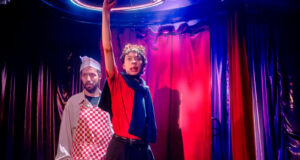Pros: Very interesting insight into OCD.
Cons: It’s a snapshot and nothing more Ever heard anyone say, “I’m being a bit OCD”? Well this is a startlingly truthful snapshot of what the thought processes are like when you live with it, however, there isn’t much more to it than that.
Summary
Rating
Poor
One of the joys of theatre is that it is rife with context. It could be looked at as an opportunity for Dean to up her game and capture the inquisitive room through resonance, but this doesn’t happen. The style of the narration is set to one pitch and one cadence which, whilst allowing intellectual absorption of what she is saying, doesn’t manage to create emotional osmosis for you to lose yourself in her world, especially as a result of the continued ambient festivity.
Her story is her own. It’s about a lifetime of OCD thoughts, about how she continuously worries and continuously seeks control. It’s about how other people and their experiences are like arrows with the way they target her well-being and shatter her peace of mind.
The piece is interesting, but there are 45 minutes of these experiences that we grasped the nature of within the first 10. There are some funny moments and she lightly brushed on the impact of her OCD and her close relationships, but never to the extent where we get a full picture of her life, or journey with her along an interconnected set of events or theories. Theatre doesn’t necessarily need to follow a climax formula, but I think there is necessity for evolution of some kind, be it in the mood, the character, the set of events or the zeitgeist, but there is none to be found here.
Perhaps that was the point. Perhaps her life is only how many times she needs to touch the windowsill; other people and her surroundings are merely visitors into a worrisome world. That is quite shocking in itself, but there’s not enough event related context for us to make those suppositions with confidence.
There is also the question – why is this theatre? Every artform is created (originally) in a certain medium for a reason. There must be something about the aesthetic which lends itself particularly to the story being told. Head Hand Head was a monologue. It had lights up and lights down. It had a voice over which replicated the monologue. Dean remained seated for most of the performance. There was a chair and a lamp she seldom interacted with and a basket with water bottles she laid out on the stage. As it was a telling of what the inside of her mind I had trouble understanding the integral nature of these objects and actions to her story. This makes me wonder why the performance wasn’t a podcast or a Radio 4 show. It could be incredibly powerful in that context, taking her inner monologue straight into your ear. I was quietly disappointed by the fact that the craft of theatre wasn’t used to full effect. Dean shares such a unique experience, one that so rarely penetrates the public consciousness, it could use the reality-blending tools of theatre to great effect. I hope this happens in future.
Author and Performer: Laura Jane Dean
Devised with: Daisy Orton
Designer: William Aubrey-Jones
Booking information: This show is currently touring. For more information on this show the author’s page at http://laurajanedean.com/head-hand-head
 Everything Theatre Reviews, interviews and news for theatre lovers, London and beyond
Everything Theatre Reviews, interviews and news for theatre lovers, London and beyond




A stylistic point: you should stick to “Ms Dean” or “Laura”. Switching between the two comes across as jarring and unprofessional.
Absolutely agree – thanks for pointing it out! We’ve updated the review.